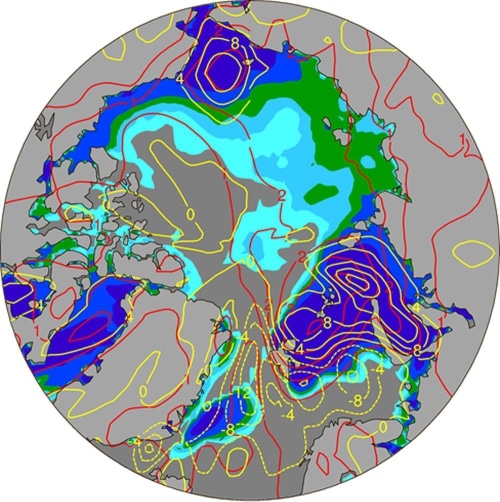Mar 11 2019
Recent observational investigations as well as model simulations with increasing emissions of greenhouse gases (GHGs) have revealed enhanced warming in the Arctic (north of 67° N).
 Sea-ice loss plays a vital important role in extraordinary Arctic warming. (Image credit: Aiguo DAI)
Sea-ice loss plays a vital important role in extraordinary Arctic warming. (Image credit: Aiguo DAI)
Compared to other places on Earth, global warming is happening twice as fast in the Arctic. Conversely, the fact that the largest Arctic amplification (AA) is only limited to specific periods over areas having a considerable sea-ice loss is still a matter of intense debate.
The answers to this puzzle were found by researchers from the State University of New York, Albany and Institute of Atmospheric Physics, Chinese Academy of Sciences using climate model simulations and historical data analyzation. The researchers’ analyses pointed out that AA would not reduce until the 22nd and 23rd centuries, after nearly all the sea ice of the Arctic has melted away with increasing emissions of GHGs.
Rapid Arctic warming and sea ice loss are attracting a lot of attention in the media, public and scientific community. Our study links the two together and suggests that the sea ice loss is causing the rapid warming in the Arctic. When the sea ice melts away completely, this elevated warming will also disappear and the warming rate in the Arctic will be similar to the rest of the world.
Aiguo DAI, Study Lead Author, The State University of New York
The new study reports that the large AA only happens in the cold season (that is, from October to April), and is only concentrated over the region that has a significant sea-ice loss. This is chiefly because seasonal melting of sea ice from May to September months leads to more widespread upper seawater, absorbing more amounts of sunlight during the phase of the warm season and storing the resultant heat energy in the sea-surface Arctic waters. A majority of this energy is discharged into the atmosphere via longwave radiation, and latent and sensible heat fluxes to heating the atmosphere at the time of the cold season when Arctic Ocean turns into a heat source, resulting in large AA.
According to researchers, the melting of Arctic sea ice will considerably contribute to global warming in the Arctic in the coming years and may even affect weather patterns in middle latitudes, prompting more frequent interruptions of winter polar vortex into the continental U.S. and China, and thus resulting in extreme events, including adverse winter weather. The study has been reported in Nature Communications.
The study is supported in part by the Chinese Academy of Science Strategic Priority Research Program (Grant XDA 19070403). D.L. is also supported by the National Science Foundation of China (Grant #41430533). A. D. is supported by the National Science Foundation (AGS-1353740 and OISE-1743738), the U.S. Department of Energy's Office of Science (DE-SC0012602), and the U.S. National Oceanic and Atmospheric Administration (NA15OAR4310086). M.S. is supported by the National Key R&D Program of China (2018YFA0605901). J.L. is supported by the National Oceanic and Atmospheric Administration’s Climate Program Office (NA15OAR4310163).